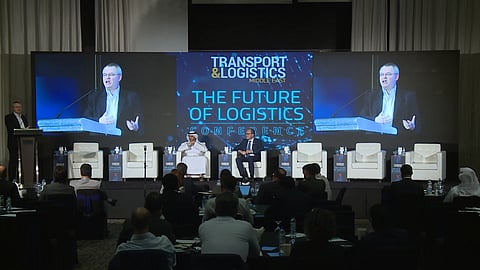Port Congestion is a Consequence of Global Ripple Effects
The second session of the Future of Logistics conference held in Dubai focussed on sea freight. Key themes for this discussion were on how to achieve stability and predictability of shipping operations and how to deploy digital and automation technologies for cargo vessels, ports and terminals.
Lars Jensen being a container cargo specialist not only moderated but was also one of the speakers for this session. The speakers included:
Shahab Al Jassmi, Commercial Director of Ports & Terminals - DP World UAE Region
Kim Larsen, VP of Commercial & Business Development (Ports) – Abu Dhabi Ports
Lars Jensen, CEO of Vespucci Maritime
Mr Jensen began the conversation by referring to the "chaos" that the shipping industry has witnessed in the last 18 months with congestions plaguing ports around the world and he asked (quite simply): “Why were the ports not working?”
Shahab Al Jassmi of DP World said, “The last two years have taught us how to adapt ourselves to meet the challenges.” As a port and service provider DP World has been preparing, planning and expanding Jebel Ali for years using the latest technologies and most advanced systems and equipment. And yet they had to face challenges during the pandemic.
The reason for that according to Al Jassmi is that it is not just "one party's responsibility". When congestion occurs at Jebel Ali, or any other port, it becomes the focal point for media and shippers' attention. But there are many stakeholders in the sea cargo supply chain including traders, shipping lines, truckers, feeders and various governments and authorities playing various critical roles.
In the last two years DP World has faced numerous complexities while supporting different parts of the supply chain. For example, when a vessel sets sail from the Far East it has many stopovers in many different countries before it arrives at Jebel Ali.
Elaborating further, Al Jassmi said that during the pandemic many countries radically altered many rules to deal with the changing scenarios and Jebel Ali has had to keep up with the changes at various ports before the vessel arrives. And then before it departs they have to ensure that it is able to dock at ports further up along the vessel's route.
Operations at Jebel Ali have consequently been affected by these changing rules in terms of stowage planning for the vessel, delayed services at prior ports, and crucially, in terms of documentation prior to vessel arrival and its subsequent departure.
Al Jassmi said that Dubai has been working very hard to automate as much documentation as possible in order to streamline the requirements of different nations and DP World has been working very closely with customers to overcome the challenges of the changing documentation requirements of various port authorities and governments.
Today, congestion is the result of a complex interplay between changing requirements and situations of the multiple stakeholders and doesn't just depend on the efficiency of one port authority or terminal operator. “So we have to compromise and we have to find customised solutions. That is the life of a terminal operator,” concluded Al Jassmi.
Agreeing with Shahab Al Jassmi, Kim Larsen of Abu Dhabi Ports, said that congestion at a port is the result of a worldwide "chain reaction". For example, he said, the congestion that we are seeing at Los Angeles Port is mainly related to the land side operations and it's about the availability of trucking and railroad capacities there.
According the Mr Larsen the UAE has invested significantly into creating a very effective port system with a very closely knit network of government agencies and private players around its ports. So it's not just about the ports but it's about connecting all players of the global supply chain more effectively in order to create greater speed and efficiencies, he said.
In Abu Dhabi there are 43 different entities connected onto a single platform to coordinate and ensure smooth port operations. Mr Larsen pointed out that key here was to connect everybody together in order to facilitate trade.
“So the main issue is not really about the ports, it is how we together resolve issues in the wider supply chain. We are very deeply involved with all the port and logistics operations. But it’s a global play and we need global partnerships to shape up things,” concluded Mr Larsen.
Speaking on the current congestion at ports across the world Lars Jensen emphasised that he “did not see this as a consequence of anyone doing anything wrong.”
Mr Jensen further added that in response to the ripples from the pandemic: “Every individual entity seems to have done the right thing at the right time.” But despite that we are where we are today.
Mr Jensen then exemplified this with the continued turbulence seen in trans-pacific shipping. As the pandemic hit different countries at different times, ports were opened and shut accordingly which lead to the chaos. This was then further complicated by a sudden surge in US demand for goods leading to more traffic and scheduling uncertainties.
According to Mr Jensen, all players including ports, shipping lines, cargo owners and freight forwarders have acted rationally at all times but they have had to deal with unpredictable global ripple effects causing unavoidable delays.
“Before the pandemic nearly 80% of vessels arrived on time... Presently we are down at around 35% of vessels arriving on time. That just makes it extremely difficult to deal with the supply chain,” concluded Mr Jensen.
Read More: Transport & Logistics on the Cusp of a Technological Transformation


